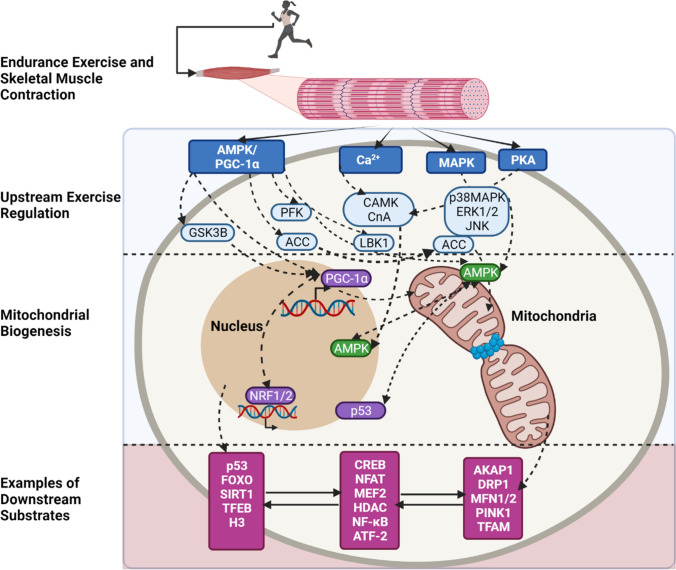Fig. 3.
Schematic of the current endurance exercise-regulated molecular landscape of kinases and signalling at the mitochondrion and nucleus. Skeletal muscle contraction in response to a single bout of endurance exercise results in increased cellular energy demands. Exercise-stimulated activation of upstream and downstream regulated signalling events from the mitochondria to the nucleus are highlighted. AMPK and peroxisome proliferator-activated receptor-gamma coactivator 1-alpha (PGC-1α) are major regulators of mitochondrial biogenesis. Stress response regulators, such as adenosine monophosphate-activated protein kinase (AMPK), mitogen-activated protein kinases (MAPK), protein kinase A (PKA) and calcium-regulated signalling cascades, involve regulation of downstream substrates and biological processes including metabolism, apoptosis and mitochondrial dynamics related to mitochondrial biogenesis. Examples of common upstream exercise regulators and typical downstream substrates are highlighted. AMPK adenosine monophosphate-activated protein kinase, PGC-1α peroxisome proliferator-activated receptor-gamma coactivator, MAPK mitogen-activated protein kinases, PKA protein kinase A, CnA calcineurin, CAMK Ca2+/calmodulin-dependent protein kinase, ERK extracellular signal-regulated kinases, JNK c-jun N-terminal kinases, PFK phosphofructokinase, GSK3B glycogen synthase kinase 3 beta, ACC acetyl-CoA carboxylase, LKB1 liver kinase B1, AKAP1 A-kinase anchoring protein 1, DRP1 dynamin-related protein 1, MFN1/2 mitofusin-1/2, PINK1 PTEN-induced kinase 1, TFAM mitochondrial transcription factor A, CREB cAMP responsive element binding protein 1, MEF2 myocyte-specific enhancer factor 2, NFAT nuclear factor of activated T-cells, HDAC histone deacetylase, NF-κB nuclear factor kappa-light-chain-enhancer of activated B cells, FOXO forkhead transcription factor, p53 tumour protein p53, SIRT1 NAD + − dependent deacetylase sirtuin-1. Created with BioRender.com

